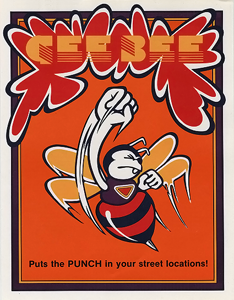Gee Bee (video game): Difference between revisions
Namcokid47 (talk | contribs) mNo edit summary |
No edit summary Tags: Mobile edit Mobile web edit |
||
| Line 8: | Line 8: | ||
|publisher = {{vgrelease|JP|[[Namco]]|NA|[[Gremlin Industries]]}} |
|publisher = {{vgrelease|JP|[[Namco]]|NA|[[Gremlin Industries]]}} |
||
|designer = [[Tōru Iwatani]] |
|designer = [[Tōru Iwatani]] |
||
|released = {{vgrelease|JP|October 1978|NA|1978}} |
|released = {{vgrelease|JP|October 2, 1978|NA|November 22, 1978}} |
||
|genre = [[Pinball]],<br>[[Breakout clone|''Breakout'' clone]] |
|genre = [[Pinball]],<br>[[Breakout clone|''Breakout'' clone]] |
||
|modes = Up to 2 players, alternating turns |
|modes = Up to 2 players, alternating turns |
||
Revision as of 06:18, 13 August 2017
This article needs additional citations for verification. (April 2011) |
| Gee Bee | |
|---|---|
 North American arcade flyer | |
| Developer(s) | Namco |
| Publisher(s) | |
| Designer(s) | Tōru Iwatani |
| Platform(s) | Arcade |
| Release | |
| Genre(s) | Pinball, Breakout clone |
| Mode(s) | Up to 2 players, alternating turns |
| Arcade system | Namco Warp & Warp |
Gee Bee (ジービー, Jī Bī) is Namco's first internally designed arcade game, released in 1978, and licensed to Gremlin Industries for US manufacture and distribution. It was designed by Tōru Iwatani, who later went on to create Pac-Man, Pole Position, and Libble Rabble.[1] When it was released in the United States by Gremlin Industries, they replaced the "NAMCO" lettering on the light-up bumpers with their distinctive "G" logo.
This is a combination of a pinball-style game with that of a ball-and-paddle game where the player bounces a ball into blocks. The goal of the game is to keep the ball from falling off the bottom of the screen for as long as possible and get the high score. Two "replays" (extra credits) will also be awarded at preset point values, depending on how the cabinet is set.[1]
There were two sequels, Bomb Bee and Cutie Q, which were also designed by Iwatani and released in the following year. The second of these was also the first game from Namco to award an extra life at a preset point value, instead of a credit.[1]
References
- ^ a b c Gee Bee at the Killer List of Videogames
External links
- Gee Bee at the Killer List of Videogames
- Gee Bee at the Arcade History database
